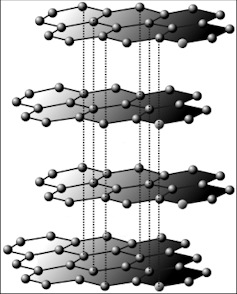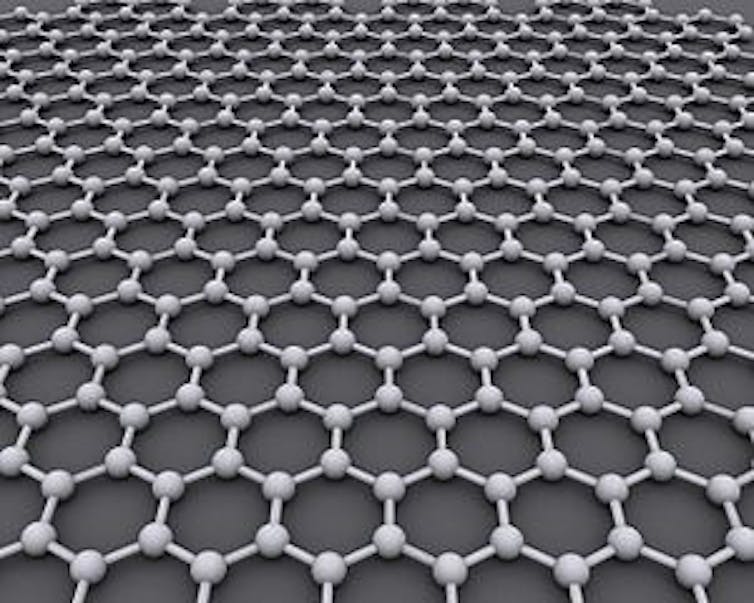Imagine a material that is just one atom thick, 300 times stronger than steel, harder than diamond, a fantastic conductor of heat and electricity and super-flexible to boot.
This might sound like the stuff of science fiction, but believe it or not, such a material already exists.
The name of this supermaterial is graphene and it’s one of the most exciting prospects in science today.

In the latest graphene-related research – released last week – researchers from Vanderbilt University found a way to overcome one of graphene’s most problematic flaws – a high sensitivity to external influences which causes graphene-based devices to operate more slowly than they should.
The researchers found a way to dampen external influences on the graphene, and could then observe electrons moving through their graphene three times faster than was previously possible.
This development could pave the way for a new generation of graphene-based devices including touch screens and solar panels.
More on the uses of graphene in a moment, but first: what is graphene?
Quite simply, graphene is a new structural form (or “allotrope”) of carbon – one of the most versatile elements in the universe. It was discovered in 2004 by Russian-born physicists Andre Geim and Konstantin Novoselov, who jointly received the 2010 Nobel Prize in Physics for their troubles.
Graphene is a single, flat layer of carbon atoms packed tightly into a two-dimensional honeycomb arrangement. The in-plane (two-dimensional) carbon-carbon bonds in graphene are the strongest bonds known to science. It is these bonds that give graphene its unbelievable mechanical strength and flexibility.

Graphene is essentially a single layer of graphite, the material found in pencil “lead”. When you draw on paper with a pencil, weakly bound graphene sheets in the graphite spread over your paper like a pack of cards.
But because graphene is so thin – the thickness of a single carbon atom – it is extremely difficult to see. This is one of the reasons it took researchers so long to find graphene sheets among thicker stacks of graphite.
Despite being so thin, graphene is an excellent conductor of electricity. Electrons flow through graphene with almost zero electrical resistance. This unusual property, and the fact graphene is nearly invisible, makes it an ideal material for the transparent electrodes used in computer displays and solar cells.
While scientists have known about graphene since 2004, it was in 2010 that researchers from Samsung and Sungkyunkwan University took a critical step in developing the commercial applications of this material.
They developed a scalable fabrication method which enabled them to produce transparent and flexible graphene electrodes measuring 30 inches (76cm) diagonally. This method enabled them to manufacture multi-layer electrode films and incorporate these into a fully functional touch-screen panel device capable of withstanding high strain.
As a result of this development, it mightn’t be too long before graphene is powering the displays on your favourite electronic gadgets.
One of the most promising aspects of graphene is its potential as a replacement to silicon in computer circuitry. Graphene conducts electricity faster (at room temperature) than any other material, it produces very little heat dissipation and it consumes less power than silicon – the building block of modern computing.
These characteristics could make graphene ideal as the basis for superior signal processing components in superfast computers and mobile technologies.
But there are still many obstacles that need to be overcome.
Probably the biggest barrier is the low “on-off current ratio” of current, superfast graphene transistors. Put another way, electrons in graphene are almost unstoppable and therefore very hard to control. As a result it is almost impossible to set graphene transistors to an “off” state.
If graphene is to compete with existing silicon technology, this on-off current ratio will need to be improved. In other words, we’ll need to find a way to control electrical currents within graphene transistors so we can turn them “off”.
Many researchers are currently working on this exact problem, trying to gain control over the disobedient charge carriers by opening a gap in graphene’s “electronic band” – the part of the material that conducts electricity.
Graphene can also be modified to take on different properties than are found in its normal form. For instance, researchers have:
- made graphene magnetic
- turned graphene into a supercapacitor, a new energy-storage device with remarkably high storage capacity and superfast energy release, and
- improved graphene’s world-leading thermal conductivity by creating “isotopically pure” graphene – graphene made from just one isotope of carbon.
Each of these modifications has potential technological applications.
Graphene sheets can also be incorporated in different composite materials, harnessing graphene’s extraordinary mechanical, thermal and electrical properties. These composite materials could lead to stronger and lighter car and airplane parts, better electrical batteries and electricity-conducting, super-tough textiles.
But perhaps one of the most surprising and unusual graphene discoveries relates to membranes made of graphene oxide – a chemical derivative of graphene.
When these membranes were used to seal a metal container, not even the smallest gas molecule, such as helium, could penetrate the membrane. But when the researchers tried the same with water, they found the water could pass through the graphene-oxide membrane with no problems.
Although the principle behind this unusual behaviour is not yet understood, it could one day be used in the selective removal of water or other filtration applications.
This surprising result shows how much we still have to learn about graphene. If current research and development is anything to go by, we’ll be hearing plenty more about this amazing material in the years to come.
Further viewing:
- Introducing graphene - European Graphene Flagship

